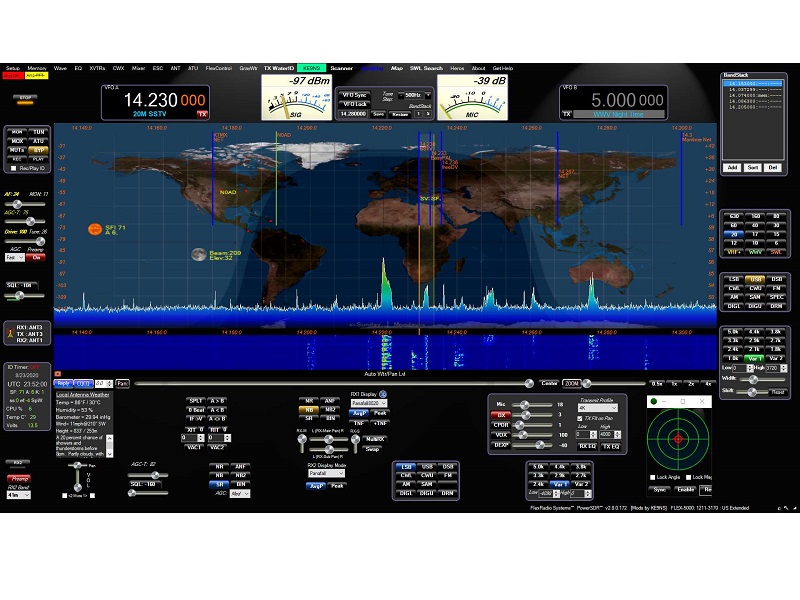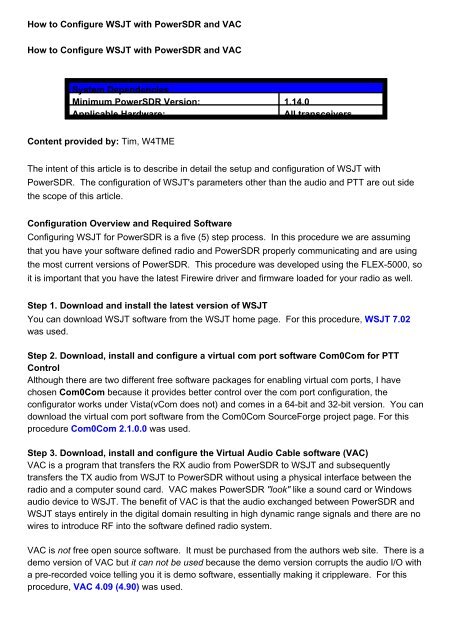

The OpenHPSDR Mercury receiver accomplishes that goal. In the OpenHPSDR Mercury and Hermes projects, the antenna is connected to a modern integrated circuit chip. The chip in this case is a very fast Analog to Digital conversion device called the LTC2208. The Mercury and Hermes designs are designed to be supplemented by bandpass, attenuation. Nutsvolts200810 Dl Battery Charger Battery. These posts assume you have already installed WriteLog 11.27 or higher, and SmartSDR v1.4.16 or higher, along with the WriteLog FlexRadio Rig Driver 11.29. Here is a screen capture running a FlexRadio with WriteLog as a single operator, listening on one frequency at a time, with the additional option of split frequency operation. May 3, 2009 HPSDR website, wiki, and e-mail lists now hosted at openHPSDR.org. April 23, 2009 LPU order page open at TAPR. March 28, 2009 The DVD's of the DCC are now availalbe. They are available from Gary KN4AQ website (arvideonews). TAPR has a link at There are several talks by HPSDR participants with very useful information.
Check related links to this in Manufacturers/Software Defined Radio
00:00:ABLogicModel # LOGIC MODELING CORPORATION 00:00:ACConwareCom # CONWARE COMPUTER CONSULTING 00:00:ADBrukerInst # BRUKER INSTRUMENTS INC. 00:00:AEDassaultEl # DASSAULT ELECTRONIQUE 00:00:AFNuclearDat # NUCLEAR DATA INSTRUMENTATION 00:00:B0Rnd-RadNet # RND-RAD NETWORK DEVICES.
FlexRadio Systems delivers the first truly open source Software Defined Radio transceiver for Amateur Radio use. Receive Only versions are also available for non Amateur Radio applications. Read the SDR Articles and the SDR-1000 Product Information.About FlexRadio Systems - Software Defined Radios
The resource is currently listed in dxzone.com in 2 categories. The main category is Software Defined Radio makers that is about Software Defined Radios. This link is listed in our web site directory since Saturday Jan 7 2006, and till today 'FlexRadio Systems - Software Defined Radios' has been followed for a total of 11864 times. So far received 13 votes for a total score of 5.77/10You may find other interesting sites similar to this one, under the following categories:
- Software/Software Defined Radio - SDR, Software defined radios products
- Manufacturers/Software Defined Radio - Software Defined Radios
Hpsdr

The scale is 1 - 10, with 1 being poor and 10 being excellent.
Webmaster, add a Remote rating
Related links
We thought you might also be interested in these additional resources we selected from the same category:- FUNKBOX Hard&Software - Useful hardware & software for SAT tracking ,logging, Software defined...
- SoftRock-40 - The SoftRock-40 is a small, low-cost, good-performing 'software define...
- Genesis Radio - SDR Kits - SDR Software defined radio kits, genesis SDR kits...
- SDR-Kits.net - USB-Controlled Synthesizer for Softrock RXTX and Local Oscillator Appl...
- Cross Country Wireless SDR Receiver - SDR Receiver a compact high performance HF software defined radio rece...
Visit this link
FlexRadio Systems - Software Defined Radios |
Share this resource
Share this link with your friends, publish within popular social networks or send it via email.It is becoming fashionable. After the Apple computer there came the Raspberry and Banana Pi and now the Red Pitaya.
The pitaja (also known as pitahaja or dragon fruit) is the fruit of various types of cacti, in particular the genera Hylocereus and Selenicereus. These plants occur naturally in Mexico, Central America and South America. They are also cultivated in South-East Asia in countries such as Indonesia, Malaysia, Vietnam, Thailand and the south-east of China and Taiwan.
There are three types of pitaya that are grown commercially for their fruit:
• Hylocereus undatus with white flesh and a pink-red skin
• Hylocereus polyrhizus with red flesh and a pink-red skin
• Selenicereus megalanthus with white flesh and a yellow skin
The pitayas with the pink skin have relatively little flavor, this is because the fruit is generally harvested too early in the country of origin and the fruit does not continue to ripen, unlike bananas for example. In contrast, the yellow pitaya from Colombia always tastes sweet, the taste does somewhat resemble that of kiwifruit. The pitayas can be cut in half and the flesh removed with a spoon, it is also possible to peel it before eating. The seeds can be eaten too. Many actually appreciate the seeds when consuming the fruit.
Source: Wikipedia.
The Red Pitaya
The Pitaya that is the subject of this blog is, however, something completely different. Not edible, but measurable.
Red Pitaya is an open source project developed around a re-configurable measurement instrument the size of a credit card. It can replace many expensive laboratory measurement and control instruments.
The users can start using the applications available within the ‘Bazaar’ free of charge marketplace. This can be achieved with a single click. At the same time they can view and modify the published source code in order to develop new applications and share their results with the community.
The Red Pitaya unit is a network attached device based on Linux operating system. It includes Radio Frequency signal acquisition and generation technologies, FPGA, Digital Signal Processing and CPU processing. Red Pitaya enables everyone to start using technologies, which were previously available only to advanced research laboratories and industry.
Source: http://wiki.redpitaya.com/
Why Red Pitaya?
Now with that knowledge we’re are already a long way in the right direction. But why is the Red Pitaya now considered so ‘hot’ by various amateur radio enthusiasts in the Netherlands? I think a number of developments are responsible for that:
• There has been a lot of activity in the open-source world to make the Red Pitaya measurement platform also suitable for SDR (Software Defined Radio). With thanks to Pavel Demin.
• The Red Pitaya has been halved in price. According to the January 2015 brochure from Reichelt, at that time the board cost twice as much as what it costs now (end of 2015).
• Heated debates on 3630 kHz about the various SDR solutions (FlexRadio (old and new), ANAN, HackRF, ELAD, ZEUS etc.).
And there are probably even more reasons. However, my interest was triggered because Onno, PA0ONO was already operational with a Red Pitaya transceiver and then, well, as an SDR man I did not want to be left behind. As one of the first users of the FLEX-1500 in the Netherlands and the promoter since 2006 of the various SDR receivers, I was keen to take a closer look at the Red Pitaya. Because I know from experience that Reichelt are very quick to deliver, I therefore ordered the Red Pitaya from them, and it was delivered by UPS within 2 days. Including the enclosure.

Unpacking Red Pitaya
I was actually planning to spend the next few weeks quietly experimenting with my new toy and to try various things. But as usual, enthusiasm got the better of me and so full-speed ahead. Embracing simplicity, here is a summary of what you need to do.
Download Flexradio/openhpsdr.org/acquisition Logic Drivers License
NB: These are instructions of how to install a fully fledged transceiver straight away. There are also other other solutions available for receive-only, using the programs SDR# or HDSDR.
• Make sure that you have a USB power supply (5 Volts, 2 A) with micro USB connector
• Buy a micro SD cart with at least 4 GB capacity
• Go to this website: http://redpitaya.com/quick-start/
• Download the Image and copy it to the SD card using Win32 Disk Image
• Follow the subsequent instructions on the quick-start website.
Openhpsdr Thetis
Once you have completed all this and have entered the MAC address you will, if all is well, see the page shown below in your browser:
(perhaps you still have to register and log in at the Red Pitaya.com website)
